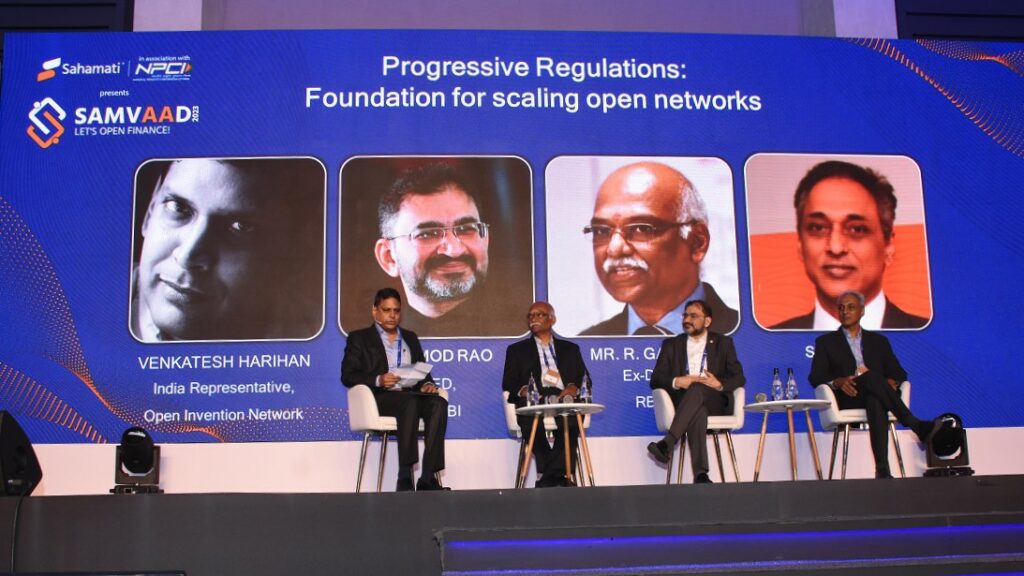Progressive regulations: Foundation for scaling open networks
- SamvAAd2023 panel with Pramod Rao, R. Gandhi, S. Ramann, moderated by Venkatesh Hariharan.
- Discussion covered techno-legal regulations, regulatory sandboxes, and new use cases for Account Aggregator (AA).
- Regulators embedding regulations at the core of technology could help community better
- Account Aggregator framework eliminates friction, consolidates KYC, and enables cash flow based lending, among other uses.

SamvAAd2023 saw a panel discussion titled, Progressive regulations: Foundation for scaling open networks which had Mr. Pramod Rao, ED, Securities and Exchange Board of India (SEBI), Mr. R. Gandhi, former Deputy Governor, Reserve Bank of India, S. Ramann, Chairman and Managing Director of the Small Industries Development Board of India (SIDBI) as panelists. The panel was moderated by Venkatesh Hariharan, India Representative, Open Invention Network.
The discussion covered a lot of ground ranging from techno-legal regulations, and regulatory sandboxes, to imagining new use cases for the Account Aggregator (AA). A quick summary is below:
India Pioneering Techno-Legal Regulations
Hariharan set the context by saying that India is at least 10-20 years ahead of the rest of the world in Digital Public Infrastructure (DPI) and this will help the country build the world’s most modern financial infrastructure in the next 5-10 years. He said that, with the AA, India is also pioneering techno-legal regulations, a concept so new that a query on search engines, or even ChatGPT does not deliver relevant results.
Mr. Gandhi explained that the standard belief was that regulations should be technology neutral. However, with the increasing usage of technology, regulators have started asking if we can embed regulations at the core of the technology itself.
Expanding on that, Mr. Rao said that, with the advent of technology, users, regulators and policymakers figured out that if the legal requirements are addressed [in the technology itself], it helps the community better than if it is addressed outside the technology, or addressed differently. ATMs can be considered an example of a techno-legal contract because the bank and consumer agree that entering the PIN into an ATM is sufficient for transacting.
He said that India has taken the concept of techno-legal regulations forward with the consent architecture which now allows transfer of data with the individual at the center. This is enabled by the consent artifact, which correlates to the technological standards.
Multilateral and Cross-sectoral use cases
Another important aspect for which RBI and the FSDC deserve credit is the fact that [entities regulated by] all four financial sector regulators can exchange information with the consent of the customer with one another. Rao likened the AA to multilateral treaties because AA eliminates the need for each Financial Information User (FIU) to sign a bilateral treaty with each Financial Information Provider (FIP). He added that AA has removed a huge amount of friction and without AA it would have taken 10 years to cover all the financial sector players.
Mr. Raman brought in another perspective when he said that AA could be used to replace the multiple Know Your Customer (KYC) requirements like SEBI’s KRA, RBI’s cKYC and the eKYC. He said that, as a country, we have done great initiatives in different pockets but we need to really consolidate KYC. AA is probably the best way forward because an FIU can pull their KYC details from the KYC done by a user’s bank. This may need a few changes because the Prevention of Money Laundering (PML) Rules Are closely linked to the Financial Action Task Force (FATF) recommendations but it is [technically] possible. He added that with the Goods and Service Tax Network coming on board the AA, there is an opportunity to unlock cash flow-based lending using purchase invoices. He pointed out that the Ministry of Micro Small and Medium Enterprises (MSME) has created a platform called Udhayam which will issue Udhayam numbers to MSMEs. This will bring four to five crore entities that have proper KYC into the ecosystem in the next 12 months.
Always remember, there is a Regulator
Ramann added that entrepreneurs should engage with the cross-sectoral sandboxes that have been set up. Entrepreneurs who feel they are working on edge cases should engage with the regulators who are keen to encourage innovation. However, he cautioned that those who are crossing the bounds of a consent-based architecture could hurt the entire system through abuse and misuse.
One of the lighthearted moments during the panel came when Hariharan asked Mr. Gandhi for his one-sentence advice to the innovators in the audience. Mr. Gandhi replied, “Always remember, there is a regulator,” which sent ripples of laughter through the audience.
Mr. Rao said that wherever there are information deficits, there is a use case for AA. He said that they are exploring use cases like making succession an easy process. When people die, can AA help identify where nominations are lacking, enable asset discovery etc? It was always anticipated that this would go beyond just the financial sector. For example, health records are required not just by the doctor but also by the health insurer who’s going to reimburse the expenses. He said that AA’s use cases are only limited by imagination.
Watch the full discussion here:
In conclusion, the panel discussion at SamvAAd2023 highlighted the significance of progressive regulations, techno-legal frameworks, and the potential of Account Aggregator (AA) in revolutionizing the financial landscape. The experts emphasized the importance of embedding regulations within technology, streamlining KYC processes, and fostering innovation through cross-sectoral collaboration. The AA was recognized as a powerful tool for enabling data sharing, eliminating friction, and unlocking new opportunities for financial services. The discussion showcased India’s leadership in digital infrastructure and its commitment to building a modern, inclusive, and efficient financial ecosystem.
We would like to thank Venkatesh Hariharan, India Representative, Open Invention Network for moderating this panel and also helping us cover the discussion.
